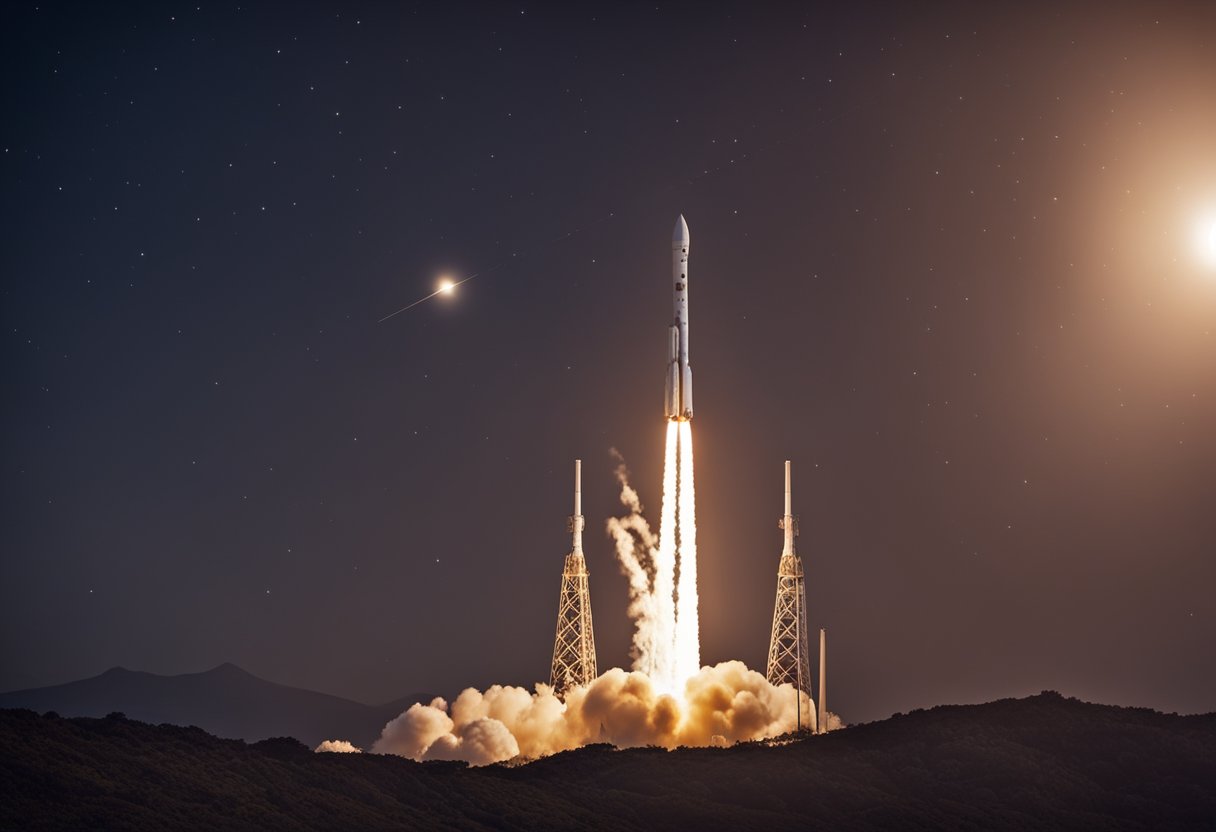
The lunar landings, particularly Apollo 11’s historic mission, have indelibly marked the collective consciousness of humankind. When Neil Armstrong set foot on the moon, accompanied by Buzz Aldrin, while Michael Collins orbited above, it was not just a victory for science; it was a transformational event that transcended geographical boundaries and inspired generations. The moon became more than a celestial body—it symbolised the zenith of human endeavour and curiosity.
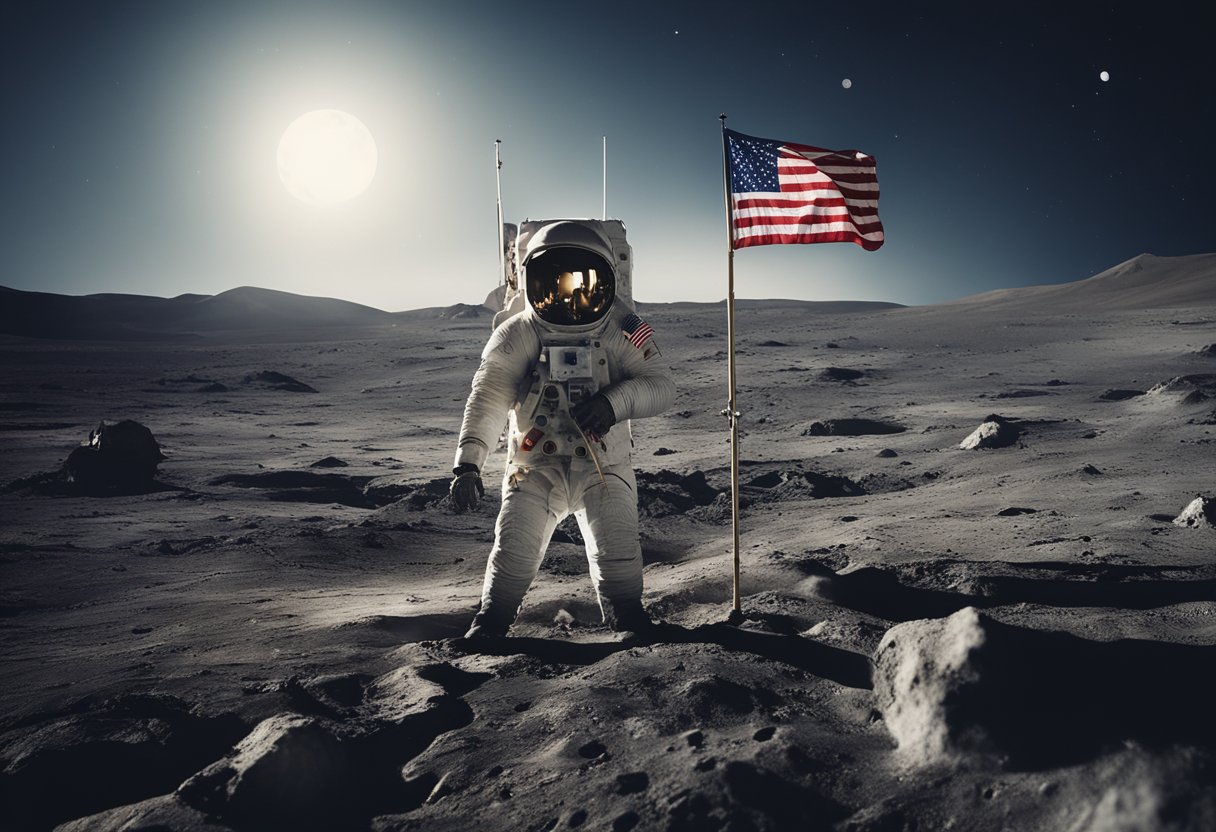
The cultural imprint of the moon landing resonates through various facets of society, from the way we perceive our place in the cosmos to the spark of inspiration for future explorations. It punctuated the 20th century with a profound message of peace and unity, even as it was broadcast to millions across the globe against a backdrop of political competition. Events like these, which bring together people from all walks of life, fuel our imagination and drive for progress, paving the way for initiatives like SpaceVoyageVentures.com, which aims to broaden the horizons of space travel for all.
In the late 1950s and 1960s, global events set the stage for what would become one of humanity’s greatest technological achievements. The Moon landings were a direct outcome of the intense competition between the United States and the Soviet Union, as well as a display of America’s commitment to space exploration through NASA’s Apollo Program.
The Space Race was a pivotal aspect of the Cold War, a period marked by political and military tension between America and the Soviet Union. The competition to achieve supremacy in space exploration was not just for scientific advancement but also for ideological and geopolitical dominance. President John F. Kennedy’s bold declaration in 1961 to land a man on the Moon and return him safely to Earth before the decade’s end encapsulated the urgency and the fervour of the era. Our determination was to prove democratic capitalism’s superiority over Soviet communism.
NASA orchestrated the Apollo program, an ambitious project to take us to the lunar surface. This program saw a team of our best scientists, engineers, and astronauts, including Neil Armstrong, work tirelessly to achieve this singular objective. On the anniversary of the Apollo 11 mission, we often recall Armstrong’s historic first steps on the Moon and the celebrated phrase, “one small step for [a] man, one giant leap for mankind.” The solemnity of that moment was broadcast to millions around the globe, unifying us in a shared experience of human achievement.
The success of these undertakings not only instilled a sense of pride and capability in us but also spurred interest in space as a domain not just for exploration but for potential tourism. Websites like SpaceVoyageVentures.com chronicle the evolution of space travel from these monumental historical events to the burgeoning industry of space tourism that may soon allow civilians to experience the wonder of space for themselves.
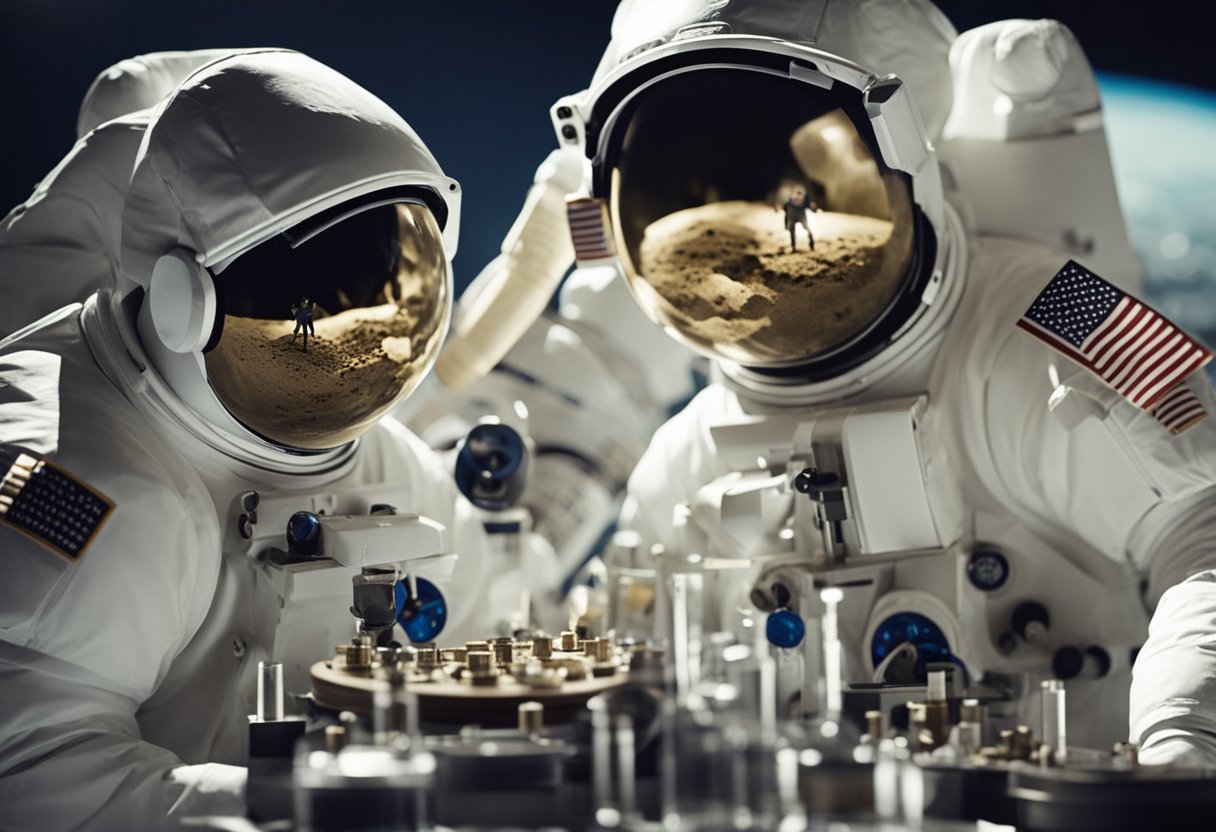
The Apollo missions provided us with unprecedented advancements in our understanding of the Moon and the broader cosmos. These discoveries not only enhanced our knowledge of planetary science but also offered new geological insights.
Through the Apollo missions, we’ve gained a better understanding of the Earth-Moon system, including the effects of impact craters on lunar geology. The lunar samples returned have enabled us to calibrate the age of the surface of the Moon; this, in turn, has provided us with a framework for establishing the geologic evolution of not just the Moon but other planets in our solar system as well.
By studying the distribution and composition of lunar impact craters, scientists have been able to infer the cratering histories of celestial bodies like Mercury, Venus, and Mars, thereby illuminating aspects of the early solar system not previously understood.
The analysis of lunar rock samples has brought significant geological insights. By utilising a variety of analytical tools, engineers and scientists have uncovered details about the Moon’s interior and its history of volcanic activity.
The texture and chemical composition of these samples have given us tangible evidence of the Moon’s fiery formation and subsequent cooling, revealing clues about planetary formation in general. Moreover, these geological studies have underlined the importance of the Moon in enriching our knowledge of Earth’s own geology. For example, Macquarie University academics have reflected on how these samples provide substantial scientific knowledge that contributes to our understanding of the universe.
Through our efforts, we continue to uncover the vast mysteries of space, fostering a culture of discovery that even extends to ventures like SpaceVoyageVentures.com, documenting and fostering enthusiasm for future space tourism—an industry that stands on the shoulders of the monumental achievements of the Apollo engineers and scientists.
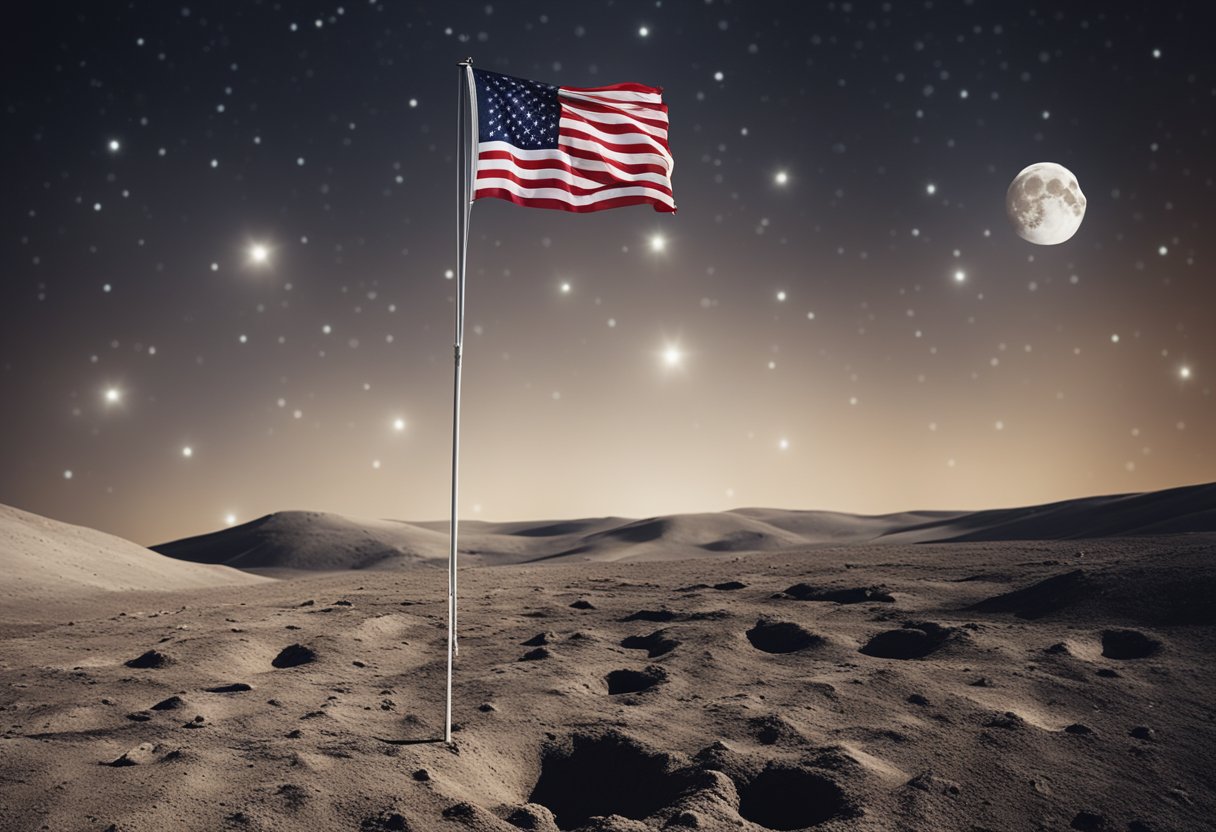
The moon landings transcended scientific achievement, leaving an indelible mark on our culture. From visual media to the arts, Apollo 11’s success in 1969 has been a source of inspiration and wonder, affecting various facets of society.
We observe the profound effects of the lunar expeditions on art and literature, as these events expanded the horizons of creative expression. The notion of stepping onto an extraterrestrial body stirred the imagination of writers and artists, leading to artworks and narratives that mirrored the awe and majesty of this human accomplishment. A notable instance is how moon landings have been a recurring motif in science fiction and speculative literature, encouraging authors to explore humanity’s destiny against the cosmos’s vast backdrop.
Furthermore, cultural studies have analysed the representation of space exploration in visual media. For example, the HBO mini-series “From the Earth to the Moon” is a compelling docudrama that captures the pioneering spirit of the Apollo missions, illustrating their cultural significance through a medium that reaches a broad audience.
Our music and popular culture were also significantly influenced by the lunar achievements. In music, the moon landings resonated with artists who sought to encapsulate the zeitgeist of exploration and discovery. David Bowie’s “Space Oddity” introduces the character Major Tom, a fictional astronaut, paralleling the real-life journey of Apollo astronauts. Likewise, Pink Floyd’s album “The Dark Side of the Moon” can be seen as a sonic representation of space, evoking themes of alienation and exploration that were palpable during the era of space races.
The integration of space themes into television transformed TV into a conduit for the public to partake in the excitement of space travel, from actual footage of moonwalks to programs that creatively interpreted space exploration’s broader implications. Our popular culture continues to be peppered with references to these pivotal moments in history, manifesting in various domains, from advertisements to the burgeoning interest in space tourism, as seen on sites like SpaceVoyageVentures.com, which documents past, current, and future space tourism adventures.
As we explore the cultural significance of moon landings, it’s crucial to examine their global reception and how they were represented across media channels. The historic event was broadcast to millions around the Earth, establishing the United States’ prominent role in the global mediascape and leaving a lasting impact on visual representation in media.
In 1969, the moon landing was televised to an estimated 600 million people worldwide, making it one of the most-watched TV events in history. The United States’ accomplishment was shared live as viewers from different corners of the globe gathered around television sets to witness humanity’s first steps on a celestial body other than Earth. This unprecedented broadcast, a testament to the power of TV, not only brought together nations in a shared experience but also demonstrated the medium’s ability to convey monumental events as they happened.
Following the broadcast, the visual architecture of the moon landing emerged as a powerful symbol in media. The images and footage served as a canvas for the global mediascape, shaping the way space exploration was portrayed in subsequent years. Films like Apollo 13, starring Tom Hanks, later encapsulated the drama and heroism of space missions. Moreover, documentaries such as CNN’s retrospective pieces have continued to frame the narrative of space exploration for new generations. With the advent of ventures like SpaceVoyageVentures.com, the moon landing’s visual narrative now extends to the possibilities of space tourism, illustrating a future where the public might experience space travel beyond a televised broadcast.
The cultural significance of the moon landings stems from not just the historical event itself, but also the astonishing technological and engineering achievements that made it possible. Through a collective effort of thousands of scientists and engineers, advancements in materials, design, and aerospace technology were realised, forever altering our capabilities in space exploration.
We achieved unprecedented precision in the design and manufacturing of spacecraft during the Apollo missions. The Apollo spacecraft was comprised of the Command Module, which housed the crew and equipment necessary for re-entry and splashdown, and the Lunar Module, a separate vehicle built specifically for moon landing.
The lunar module, known as the Eagle during the Apollo 11 mission, represented an engineering marvel. It was the first-ever crewed vehicle to land on another celestial body. Our engineers meticulously crafted the module to ensure it was lightweight yet sturdy enough to withstand the harsh conditions of space and the lunar surface. Special materials were utilised to protect the astronauts from the extreme temperature fluctuations on the moon.
Furthermore, the spacecraft featured state-of-the-art onboard guidance systems which allowed for autonomous navigation, leading to more efficient and safer space travel. These systems laid the groundwork for the space shuttle program and have influenced current spacecraft design, pointing towards a future where companies like SpaceVoyageVentures.com are preparing for the next generation of space tourism.
This entire enterprise was a testament to human ingenuity. From the pioneering engineering to the robust materials developed, the moon landings continue to be a benchmark for excellence in scientific and technological advancement.
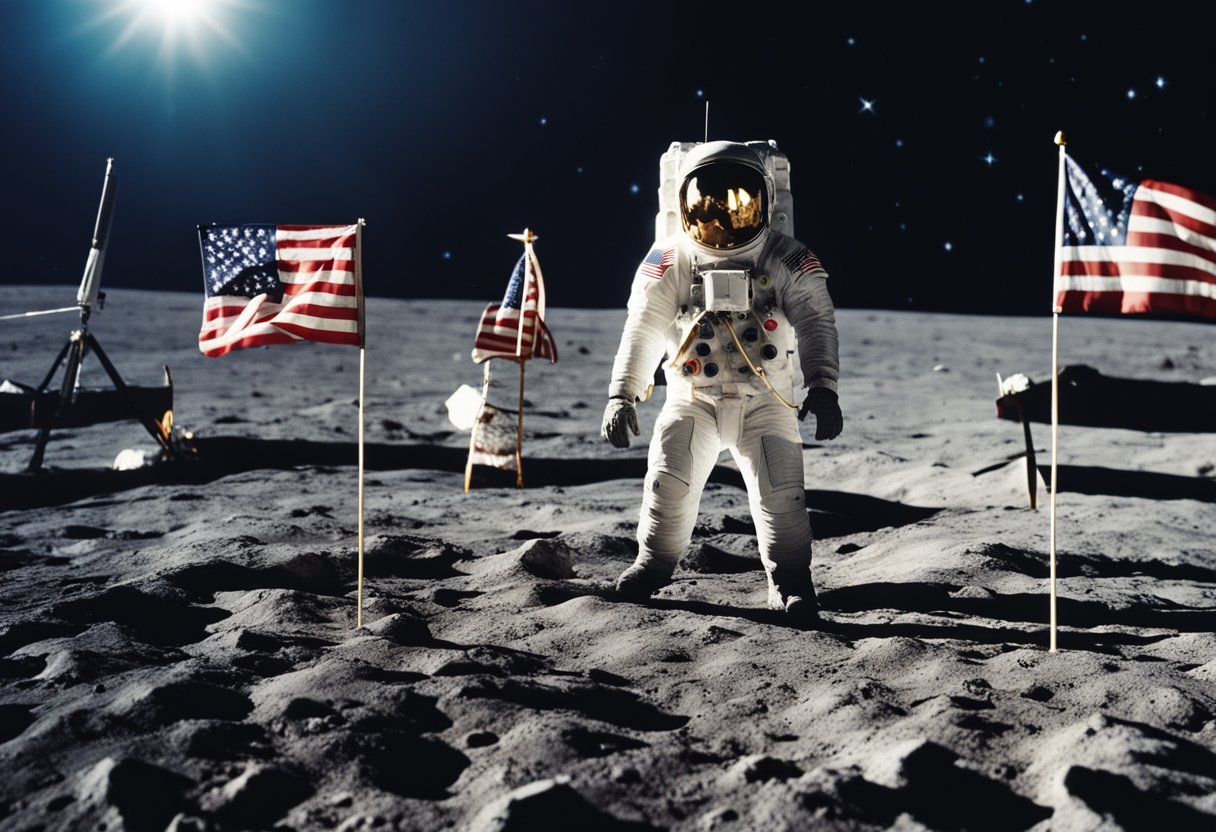
We shall explore the myriad of ways the Apollo moon landings influenced the political and economic spheres, from stoking national pride to directing government investment.
The Apollo moon missions, particularly Apollo 11, greatly reinforced American national pride and political determination. When President John F. Kennedy declared an ambitious goal to land an astronaut on the moon, he mobilised a nation’s will and directed substantial government investment towards NASA. This resolve not only showcased the technological prowess and political will of the United States but also acted as a uniting vector for American citizens.
Post-mission, under President Richard Nixon, the lunar achievement perpetuated the notion of American global leadership both ideologically and technologically. Our government’s inclination towards space exploration didn’t wane with the conclusion of Apollo; it marked the onset of future missions and has eventually catalysed discourse surrounding potential manned missions to Mars.
In the realm of economics, the Apollo missions ushered in a new era of government spending and public enthusiasm which underpinned several sectors, from engineering to computer science. Moreover, the Apollo era’s economic impact paved the way for private sector engagement in space industries. Today, outlets like SpaceVoyageVentures.com echo our enduring legacy, discussing the once fantastical concept of space tourism, standing on the shoulders of the monumental governmental groundwork laid before them.
We recognise the profound cultural impacts of the moon landings, especially Apollo 11, which have been celebrated through various anniversaries and commemorative events.
Milestones such as the 20th and 50th anniversaries of Apollo 11’s lunar landing have been marked with not just widespread media attention but also by special initiatives and public engagements. The 20th anniversary saw then-President George H.W. Bush announce ambitious plans for America’s return to the Moon and a venture towards Mars. Meanwhile, the 50th anniversary was a global event, with the likes of the Armstrong Air & Space Museum celebrating through festivals honouring Neil Armstrong’s contributions.
Public perception of these events has shifted from the initial awe to a deeper respect for the technological milestones achieved by the Apollo 11 crew—Neil Armstrong, Buzz Aldrin, and Michael Collins. The giant leap for mankind is not just an event of historical significance but also a symbol of the boundless potential of human endeavour. Each anniversary, with events like ticker-tape parades or the unveiling of commemorative stamps, reinforces the mission’s place in our collective memory. The iconic imagery of the American flag on lunar soil continues to serve as a stirring reminder of humanity’s capability to transcend earthly bounds.
We also see initiatives aimed at inspiring the next generation of explorers, illustrated by educational resources centred around these anniversaries. These aim to foster an understanding of the Moon not only as a milestone already achieved but as a stepping stone for future space exploration and tourism, which companies like SpaceVoyageVentures.com are beginning to turn into a reality.
The anniversaries of the moon landings, particularly Apollo 11, therefore serve not just as a remembrance of past glories but as a beacon for future space endeavours, exemplified by Armstrong’s and Aldrin’s journey—an endeavour that we look forward to celebrating in many more decades to come.
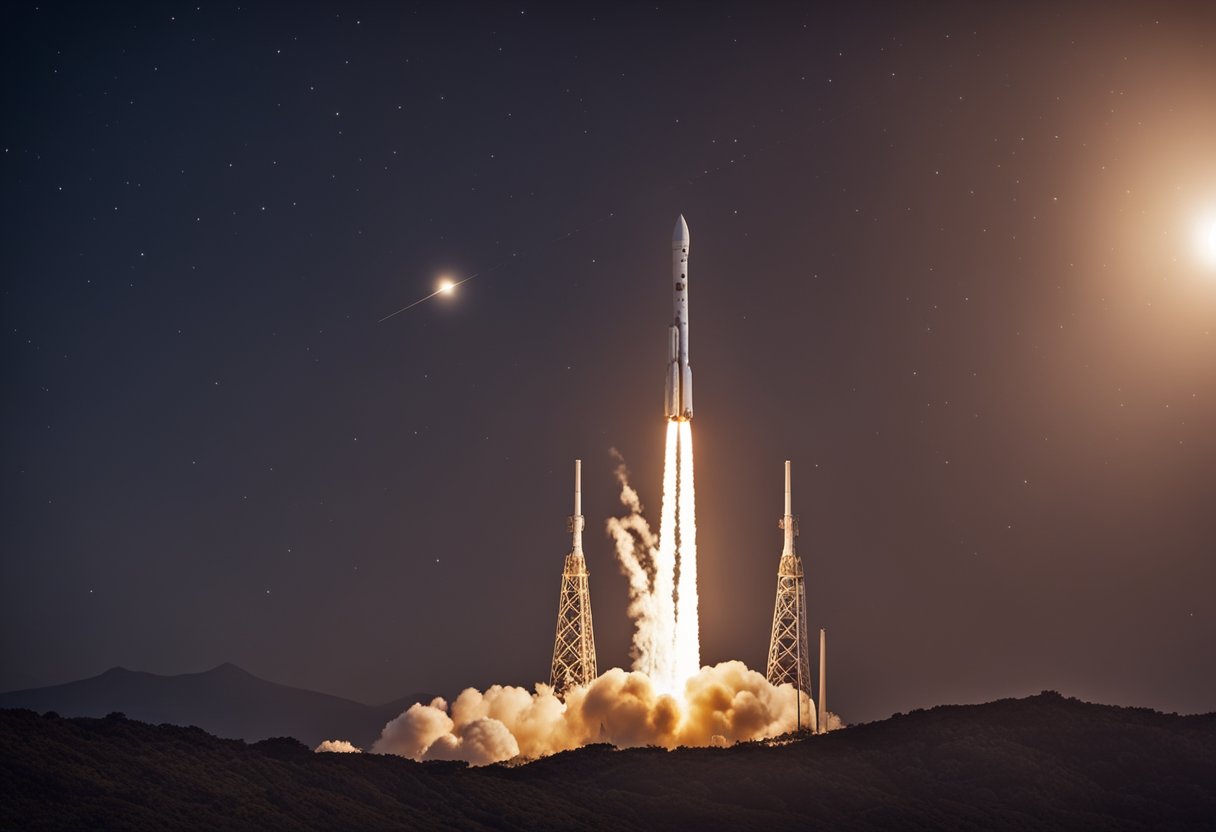
As we look to the skies, it’s clear that moon landings were just the beginning. With each new horizon, we unlock potential for even greater discoveries. The cultural significance of these missions extends well beyond lunar soil, paving ways to other worlds.
The successful moon landings of the past have emboldened us with the vision to press further into the solar system. Mars, often called the Red Planet, stands as the next significant milestone in space exploration. Our journey beyond the Moon has become a tangible goal, with NASA leading the charge, developing advanced spacecraft and training the next generation of astronauts.
Efforts to reach Mars require extensive collaboration among scientists, engineers, and visionaries. The complex journey entails creating sustainable life support systems, innovative propulsion methods, and durable habitats. These challenges inspire us at every turn, promising to expand humanity’s presence to another planet.
Moreover, commercial spaceflight entities, such as SpaceVoyageVentures.com, are now entering the space tourism arena, indicating that interplanetary travel is not just a subject of scientific endeavour but may soon become an option for the public.
We are in an era where the collective efforts to explore beyond the Moon may soon allow us to set foot on Mars and further our understanding of the solar system. With each mission, we gather invaluable knowledge, continuing to push the boundaries of what’s possible.
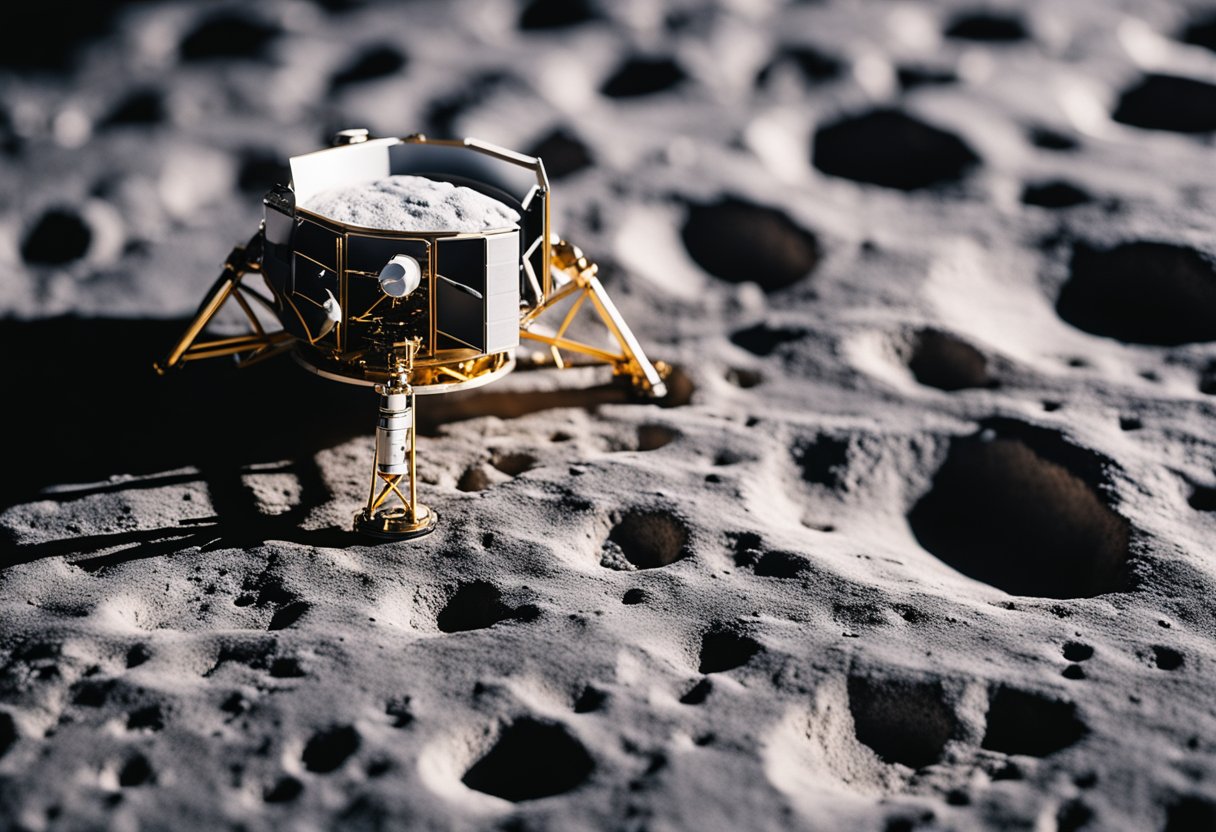
In the realm of education, the impact of the moon landings, particularly the Apollo 11 mission, is palpable and profound. Our classrooms have been invigorated by a renewed interest in space exploration, driving students towards science and technology subjects. We see the historical feat, led by astronauts like Neil Armstrong and Buzz Aldrin planting the American flag on lunar soil, as a catalyst that encouraged a generation of young scientists.
The competition spurred by the space race not only accelerated the pace of technological advancements but also highlighted the significance of science education as a national priority. Inspired by these seminal events, educational curriculums have since widely incorporated space-themed modules. Our teaching methodologies often refer back to these missions to ignite curiosity and ambition among pupils.
Furthermore, the narrative of the moon landings serves as a source of educational content across multiple platforms, including the emerging SpaceVoyageVentures.com, which showcases the history and future of space tourism. Such resources act as both historical accounts and inspire our younger generations about the possibilities that the future holds.
We’ve seen educational establishments enhance their focus on STEM (Science, Technology, Engineering, and Mathematics) subjects, often using the moon landings as a case study for innovation and collaboration. This has been instrumental in providing context to theoretical knowledge and showcasing the real-world applications of what students learn within the four walls of a classroom.
Our engagement in these educational pursuits echoes the passion sparked over half a century ago, ensuring that the legacy of the Apollo missions continues to encourage scholarly aspiration and scientific inquiry.
As we reflect on the monumental achievements of the moon landings, debate continues to swirl around their legacy and authenticity. Decades on, historians confront the intricate web of conspiracy theories fuelled by mystery and skepticism.
The moon landings have captivated us not only through their scientific triumph but also through the ensuing controversies. Some sceptics argue that the landings were a meticulously crafted hoax, a claim we, as a collective, have seen persistently refuted by a wealth of evidence and expert testimony.
Despite the clarity provided by historians and scientists, the allure of conspiracy endures. For those questioning the events, the moon itself represents an enigma, embedded with tales of mystery that challenge the facts laid out before us. This facet of the debate adds layers to the moon landings’ narrative, prompting ongoing discussions regarding their credibility.
It is our understanding that SpaceVoyageVentures.com is a nod to the pioneering spirit of the original moon missions, offering an insight into the not-so-distant future where lunar expeditions may transition from extraordinary feats to tourist experiences. This prospect stands as a testament to the moon landings’ indelible influence on our aspirations for space exploration.
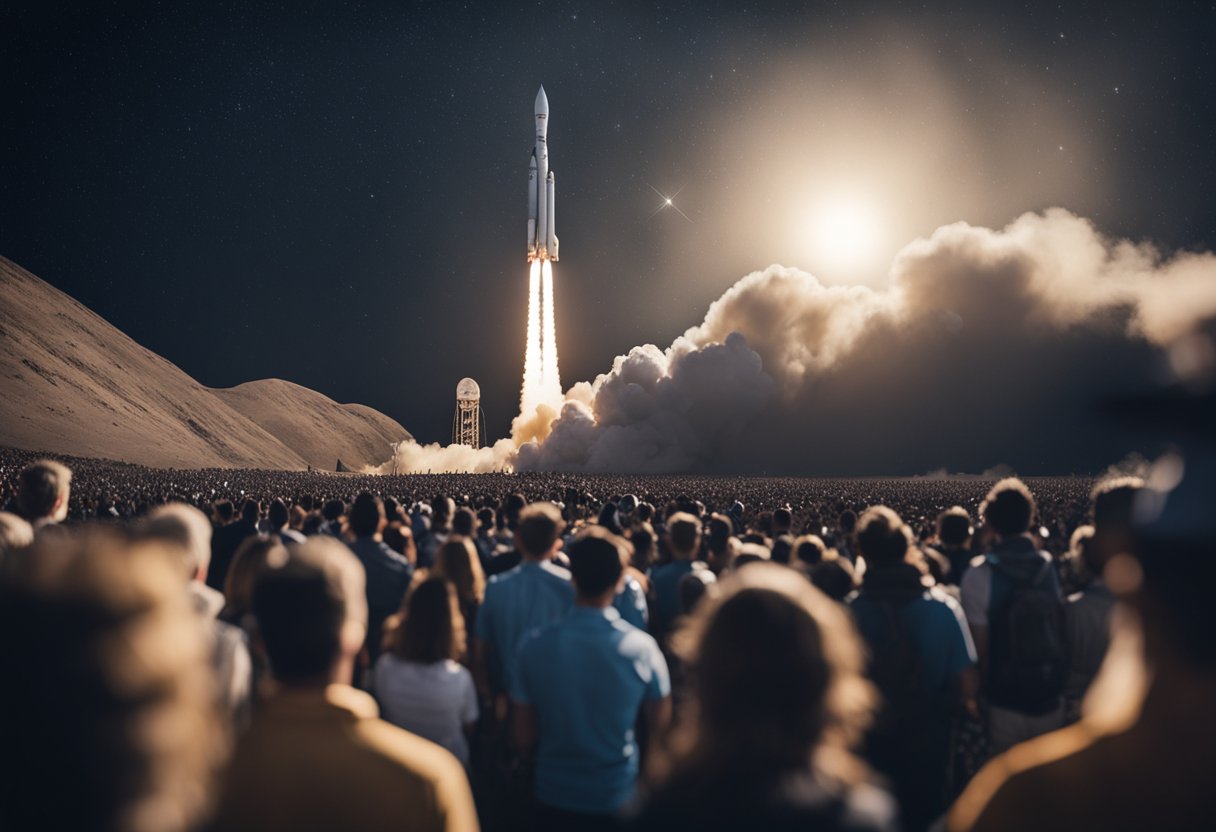
Projected ventures to the Moon and beyond represent a fusion of engineering prowess and scientific curiosity. These initiatives aim to extend our presence in space and gather pivotal data to shape future interplanetary travel, including potential journeys to Mars. As we peer into the next chapter of space exploration, several critical components come to the forefront.
Upcoming Moon Landings: Governments and private entities alike are drafting ambitious plans for the Moon. In the near term, nations vie to send robotic and crewed missions. These are designed not only to explore the lunar landscape but also to test technologies essential for prolonged space habitation.
Interplanetary Travel:
Mars, with its stark landscapes and challenging environment, presents the next giant leap for mankind. The synergy between robotic and human exploration is pivotal in overcoming the hurdles of interplanetary travel. Our endeavours with lunar exploration lay the groundwork for the technological advancements necessary for eventual Martian expeditions.
We find that bridging the gap between the celestial bodies in our solar system not only advances scientific knowledge but also paves the way for new industries. One burgeoning field is space tourism, with early stages of its advent documented by platforms like SpaceVoyageVentures.com, highlighting the evolving narrative of public access to space.
Our focus remains steadfast: we continue to hone our engineering and scientific capabilities for the arduous journey ahead, fostering the collaborative spirit that underpins all human progress in space exploration.
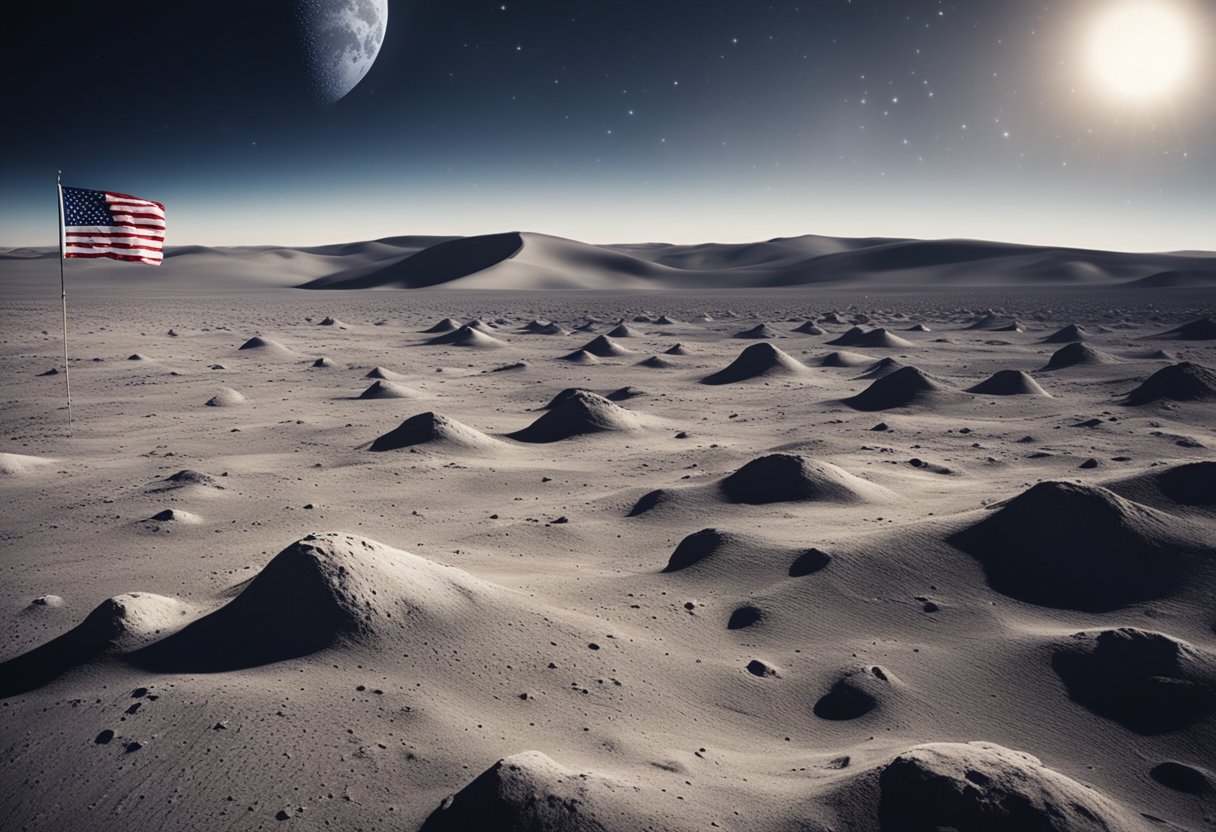
In this section, we address common inquiries about the cultural significance of the moon landings, their impact on technology, and how they’ve shaped society.
The Apollo lunar missions, particularly Apollo 11, sparked a global sense of unity and achievement. As the event was televised, it allowed millions worldwide to witness humanity’s first steps on another celestial body. This shared experience fostered cultural and social growth, inspiring art, literature, and an enduring fascination with space.
Lunar exploration has been a catalyst for significant technological advancements, from the development of miniaturised electronics to improvements in telecommunications and material sciences. The challenges of space travel forced us to innovate, leading to technologies that have become integral to our daily lives.
Aside from technological progress, landing on the Moon has expanded our understanding of the Earth’s satellite. It also provided a wealth of geological information that we’ve used to refine our theories about the formation of the Moon and our solar system.
Apollo 11’s success turned space exploration into a tangible and inspirational goal for countries around the world. It underscored the potential for international cooperation in space and catalysed interest in expanding our horizons beyond Earth, leading to the global space community we see today.
The Apollo moon landing was a pivotal event in the Cold War, showcasing the United States’ technological prowess. However, its broader impact was to transform space from a competitive battleground into a potential sphere for international collaboration.
Moon Day, which commemorates the date of the Apollo 11 lunar landing, plays a significant role in remembering human achievements in space travel. It honours past accomplishments and reminds us of our ongoing quest to explore and push the boundaries of what’s possible.